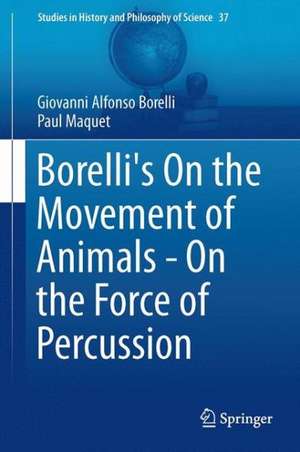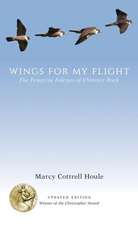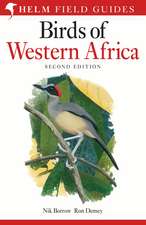Borelli's On the Movement of Animals - On the Force of Percussion: Studies in History and Philosophy of Science, cartea 37
Autor Giovanni Alfonso Borelli Traducere de Paul Maqueten Limba Engleză Hardback – 10 noi 2014
Originally published in Italian in 1667, then translated into Latin in 1686, the text of this volume has now been translated into English, making the text accessible to a wide readership.
This volume is the first of two volumes that contain the Introduction and physical-mathematical illustrations necessary to understand Giovanni Alfonso Borelli’s work On the Movement of Animals, the founding text of seventeenth century biomechanics. The second volume, entitled On The Natural Motions Resulting From Gravity, describes his theory and scientific experiments relating to the natural movements of bodies in a fluid environment.
| Toate formatele și edițiile | Preț | Express |
|---|---|---|
| Paperback (1) | 638.57 lei 6-8 săpt. | |
| Springer International Publishing – 23 aug 2016 | 638.57 lei 6-8 săpt. | |
| Hardback (1) | 644.82 lei 6-8 săpt. | |
| Springer International Publishing – 10 noi 2014 | 644.82 lei 6-8 săpt. |
Din seria Studies in History and Philosophy of Science
- 15%
 Preț: 650.19 lei
Preț: 650.19 lei - 15%
 Preț: 700.75 lei
Preț: 700.75 lei -
 Preț: 284.47 lei
Preț: 284.47 lei - 15%
 Preț: 702.24 lei
Preț: 702.24 lei -
 Preț: 389.88 lei
Preț: 389.88 lei - 18%
 Preț: 1222.94 lei
Preț: 1222.94 lei - 15%
 Preț: 647.08 lei
Preț: 647.08 lei - 15%
 Preț: 645.47 lei
Preț: 645.47 lei - 18%
 Preț: 956.33 lei
Preț: 956.33 lei - 18%
 Preț: 953.97 lei
Preț: 953.97 lei - 15%
 Preț: 646.11 lei
Preț: 646.11 lei - 15%
 Preț: 641.85 lei
Preț: 641.85 lei - 15%
 Preț: 644.49 lei
Preț: 644.49 lei - 18%
 Preț: 951.29 lei
Preț: 951.29 lei - 15%
 Preț: 647.40 lei
Preț: 647.40 lei - 18%
 Preț: 953.20 lei
Preț: 953.20 lei - 18%
 Preț: 946.87 lei
Preț: 946.87 lei - 18%
 Preț: 1384.56 lei
Preț: 1384.56 lei - 18%
 Preț: 1234.14 lei
Preț: 1234.14 lei - 15%
 Preț: 637.78 lei
Preț: 637.78 lei - 15%
 Preț: 633.53 lei
Preț: 633.53 lei - 18%
 Preț: 1219.77 lei
Preț: 1219.77 lei - 24%
 Preț: 586.94 lei
Preț: 586.94 lei - 18%
 Preț: 967.56 lei
Preț: 967.56 lei - 15%
 Preț: 641.38 lei
Preț: 641.38 lei - 15%
 Preț: 642.68 lei
Preț: 642.68 lei - 15%
 Preț: 642.03 lei
Preț: 642.03 lei - 15%
 Preț: 641.85 lei
Preț: 641.85 lei
Preț: 644.82 lei
Preț vechi: 758.60 lei
-15% Nou
Puncte Express: 967
Preț estimativ în valută:
123.39€ • 129.09$ • 102.50£
123.39€ • 129.09$ • 102.50£
Carte tipărită la comandă
Livrare economică 02-16 aprilie
Preluare comenzi: 021 569.72.76
Specificații
ISBN-13: 9783319084961
ISBN-10: 3319084968
Pagini: 215
Ilustrații: XXXVIII, 220 p. 7 illus.
Dimensiuni: 155 x 235 x 20 mm
Greutate: 0.54 kg
Ediția:2015
Editura: Springer International Publishing
Colecția Springer
Seria Studies in History and Philosophy of Science
Locul publicării:Cham, Switzerland
ISBN-10: 3319084968
Pagini: 215
Ilustrații: XXXVIII, 220 p. 7 illus.
Dimensiuni: 155 x 235 x 20 mm
Greutate: 0.54 kg
Ediția:2015
Editura: Springer International Publishing
Colecția Springer
Seria Studies in History and Philosophy of Science
Locul publicării:Cham, Switzerland
Public țintă
ResearchCuprins
Foreword of the Author.- Chapter I On the nature of movement in general.- Chapter II On the causes and principles of movement.- Chapter III Projectiles after being separated from their impeller are not moved forwards by the fluid environment in which they are. Chapter IV Projectiles are moved forwards by a virtue impressed by the throwing subject, after they are separated from the latter.- Chapter V On the properties and actions of the motive virtue.- Chapter VI How the impetus of the throwing subject is distributed and transmitted in the projectiles and why it is decreased.- Chapter VII The velocity which is transmitted by the blow to the projected body, by its nature, is distributed, not over a certain time, but in an instant.- Chapter VIII The velocity transmitted in elastic and not absolutely hard bodies by a striking blow is not impressed in one instant but in several successive instants of the time.- Chapter IX The velocity impressed in a projectile is uniform by its nature and perpetually durable.- Chapter X On the proportion of percussions carried out in a body absolutely stable or movable.- Chapter XI On the variety of percussions, which originates from the movement and the position of the bodies receiving the blow.- Chapter XII On the percussion of bodies colliding obliquely on a stable plane.- Chapter XIII On the percussion of bodies colliding in oblique movements.- Chapter XIV On the variety of percussions carried out by the impetus of a curved and accelerated movement.- Chapter XV On the rebound which follows the percussion of bodies.- Chapter XVI How the impetus is weakened and extinguished in projectiles.- Chapter XVII The impetus impressed in any body can be weakened and diminished instantaneously because of its diffusion but it an be completely deleted and annihilated only over some time, although we can suspect that movement is responsible neither of its beginning nor of its end.- Chapter XVIII How an impetusimpressed in elastic bodies is slowed down and extinguished.- Chapter XIX Why opposite movements annihilate each other and renew themselves in elastic and resilient bodies.- Chapter XX On the flow of impetus and on its magnitude.- Chapter XXI Moving bodies are urged at an uniform velocity never to be annihilated.- Chapter XXII How can an accelerated movement be generated.- Chapter XXIII On the natural motive faculty of gravity.- Chapter XXIV The force of the impetus of falling heavy bodies is smaller than any impulsive force impressed by a projectile.- Chapter XXV Digression on the reason why a magnet attracts iron.- Chapter XXVI All solid bodies are not absolutely hard but they are either fluent or soft or elastic.- Chapter XXVII On the comparison between the energy of percussion and the compressive force of gravity.- Chapter XXVIII Explanation of the problem and enquiry on the actual causes of this wonderful effect.- Chapter XXIX The energy of percussion is greater than the compressive force of any finite heavy body.- Chapter XXX On shaking of bodies.- Chapter XXXI More accurate investigation of the cause of vibration.- Chapter XXXII The smallest motive force of any body, by a slow movement, can impress and increase in a huge body a velocity greater than that at which the impeller moved.- Chapter XXXIII The impetus of a percussion cannot be measured by the simple energy of gravity.- Chapter XXXIV Examination of the question 19 in the Mechanics of Aristotle.- Answer to some considerations and objections of R.P.F. Stephano Degli Angeli, concerning his book On the force of Percussion.- Answer to Sir Michelo Angelo Ricci.
Textul de pe ultima copertă
This volume provides an introduction to Borelli’s theory on the movement of animals and demonstrates the nature of the energy of percussion, its causes, properties and effects. Building on and moving away from the theory of mechanics as formulated by Aristotle and Galileo, and countering objections expressed by Stephani degli Angeli among others, Borelli presents a completely mechanical account of the action of muscles, and analyzes the way in which the center of gravity of the animal shifts in locomotion.
Originally published in Italian in 1667, then translated into Latin in 1686, the text of this volume has now been translated into English, making the text accessible to a wide readership.
This volume is the first of two volumes that contain the Introduction and physical-mathematical illustrations necessary to understand Giovanni Alfonso Borelli’s work On the Movement of Animals, the founding text of seventeenth century biomechanics. The second volume, entitled On The Natural Motions Resulting From Gravity, describes his theory and scientific experiments relating to the natural movements of bodies in a fluid environment.
Originally published in Italian in 1667, then translated into Latin in 1686, the text of this volume has now been translated into English, making the text accessible to a wide readership.
This volume is the first of two volumes that contain the Introduction and physical-mathematical illustrations necessary to understand Giovanni Alfonso Borelli’s work On the Movement of Animals, the founding text of seventeenth century biomechanics. The second volume, entitled On The Natural Motions Resulting From Gravity, describes his theory and scientific experiments relating to the natural movements of bodies in a fluid environment.
Caracteristici
First translation into English of a major work by Giovanni Borelli First translation of Borelli's "De Motu animalium", the founding work of seventeenth-century biomechanics Of interest to historians of science generally, but especially to those interested in the history of the life sciences Includes supplementary material: sn.pub/extras








